What’s Happening Outside?
February can be cold, gray and relatively quiet, but nature is never totally dormant. Here are a few more things going on in the Dyke Marsh Wildlife Preserve and on the Potomac River this winter.
Wetlands like Dyke Marsh, while not very green, are still supporting biodiversity, storing water and acting as buffers against storms and flooding. At low tide, dead or dying spatterdock plants are spread across the mudflats. Cattails sway in the breeze.
Fish, frogs and turtles have slowed down their metabolism and some wildlife, like frogs, have burrowed into the mud to survive in a state of dormancy. Dragonflies, mayflies and stoneflies are overwintering at nymphs in their watery world.
Bald eagles along the river are incubating eggs and probably rearing young eaglets. The adults started bringing sticks to build up last year’s nests as early as November.
Some of the waterfowl that wintered here have gone north to breed and raise their young and if dark-eyed juncos are not yet gone, they will be soon. Great horned owls are hooting, searching for a mate.
Plants may not have summer leaves or flowers, but some have fruits or berries. Poison ivy’s berries are food for wildlife like Eastern bluebirds. Beware! Poison ivy’s hairy vine, like the plant’s leaves, can cause rashes on susceptible people. Cedar waxwings and American robins are feasting on American holly berries. Many bird species feed on Eastern red cedar berries.
Slowly swelling buds signal that spring is coming. Beech and red oak trees have kept last summer’s leaves all winter, but will drop them soon.
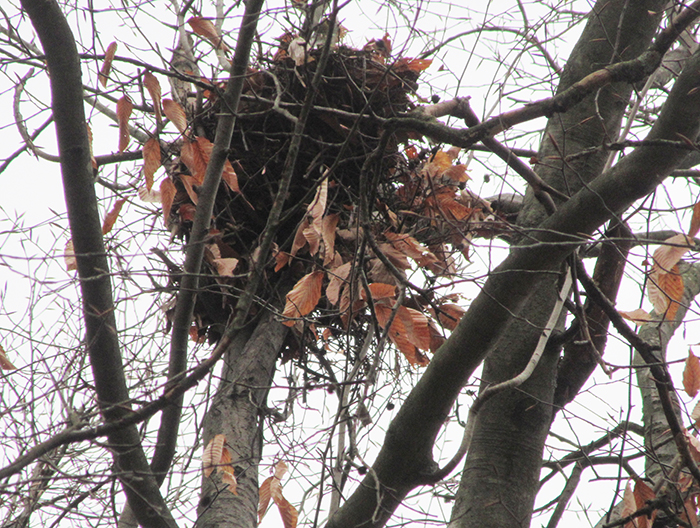
Eastern gray squirrel nests or dreys stand out in the trees. The nests are roundish clumps about 30 feet above ground and have an outer layer of brown leaves. The squirrels are preparing to house their young, born between February and April. Male squirrels chase females. part of their mating ritual.
Beavers are using their lodges. Steam rising from the lodges can indicate that the lodges are occupied.
Many insects overwinter as larvae, nymphs or pupa. Some insects like bees spend the winter inside hollow stems. If a warm day occurs, a mourning cloak butterfly may emerge, showing off its maroon wings with yellow dorsal edges. Mourning cloaks are the first butterflies to emerge in late winter. And while they consume nectar at times, they prefer tree sap.
Looking ahead to March
March weather can be unpredictable, but spring will unfold. Some blossoms will appear and overwintering insects and amphibians will emerge. Vernal pools will thaw.
Redwing blackbirds will start establishing their territories in the cattails. Listen for the male’s conk-la-lee song.
Ospreys will return, mate and reconstruct nests or build nests. Wood ducks will settle into natural cavities. Bald eagles will bring fish and other prey to their nestlings.
Restoring Biodiversity -- the Native Plant Site
Thanks to over 40 volunteers, National Park Service staff, three grants and many generous donors, in 2018 and 2019, the Friends of Dyke Marsh and partners cleared this .065-acre area and planted over 4,000 native trees and plants, a project designed restore degraded habitat and support native wildlife. We estimate that around 80 percent of the plants and trees have survived.
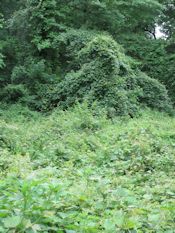 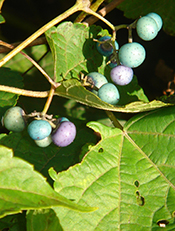 |
|
 |
Porcelainberry (Ampelopsis brevipedunculata) is rampant all along the Haul Road and outcompetes many valuable native plants.
All photos by Glenda Booth unless otherwise noted. |
|
The National Park Service and FODM created a demonstration plat, clearing the area of a massive invasive plant infestation. |
| |
|
|
 |
|
 |
|
On October 4, 2018, volunteers planted around 300 native plants. Photo by Ned Stone
|
|
On October 11, 2019, FODM volunteers and National Park Service staff put in 400 more native plants.
Photo by Robert Veltkamp |
Here are some examples of the plants you can see much of the year: Hairy leafcup or bear’s foot (Smallanthus uvedalia); riverbank wild rye (Elymus riparius); New York ironweed (Vernonia noveboracensis); deer tongue (Dichanthelium clandestinum (syn. Panicum clandestinum); Joe Pye weed (Eutrochium purpureum); common milkweed (Asclepias syriaca) and common elderberry (Sambucus canadensis). Some native plants have naturally returned, like pokeweed (Phytolacca americana) and yellow passion flower (Passiflora lutea).
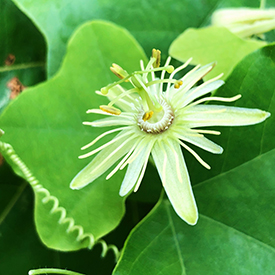 |
|
 |
|
 |
| A very welcomed surprise was the return of the yellow passion flower (Passiflora lutea) from the seed bank. Photo by Su Kim |
|
The ironweed (Vernonia gigantea) that we planted has done well.
|
|
An eastern tiger swallowtail butterfly (Pterourus glucus) nectars on a bear's foot/hairy leafcup (Smallanthus uvedalius) plant. |
| |
|
|
 |
|
 |
| Six-foot tall Joe-pye weed (Eupatoriadelphus fistulosus) plants thrive in the summer. |
|
Pokeweed plants (Phytolacca americana) have berries that turn dark purple in the fall. |
Why Plant Native Plants?
“Plants and animals evolve together to create unique natural communities, weaving a complex web of interrelationships,” according to the Virginia Department of Conservation and Recreation.
Native plants which produce nectar, pollen and seeds, serve as food for native birds, butterflies, bees and other wildlife. Many insects, like butterflies, depend on specific plants, called “host plants,” with which they co-evolved for their food and shelter.
 |
|
Carolina Chickadee
(Parus carolinensis) with
a caterpillar. |
|
| |
|
Here is one example of the importance of native plants to wildlife. At FODM’s September 2018 meeting, Dr. Desiree Narango, a University of Massachusetts ecologist, explained that native plants support a higher abundance and biomass of caterpillars than non-native plants. She said that a chickadee pair with four to seven young, needs between 390 to 570 caterpillars every day to feed their young. Caterpillars are very dependent on certain host plants.
Native plants can improve ecological functionality of landscapes and provide ecological services like habitat creation, stormwater retention, cleaner air and erosion and sediment control. Native plants can improve soil health. Healthy habitats have plants and animals (producers and consumers) in balance. A diversity of plants can help keep pest populations in check.
By installing and supporting native plants, this project is one small way we can restore and sustain biodiversity, strengthen the resource base for wildlife and for people and create a healthier environment.
Partners, Grants
Our partners in this project are the National Park Service, Earth Sangha and the Audubon Society of Northern Virginia. FODM received grants from the Audubon Society of Northern Virginia, the National Environmental Education Foundation and Transurban, operator of the I-95 and I-495 express lanes, and donations from many generous members.
Controlling Invasive Plants
 |
|
| Mara Surovell helped control invasive mile-a-minute (Persicaria perfoliata). |
|
| |
|
For many years, volunteers have diligently worked in the preserve to eliminate and control invasive species, such as stiltgrass (Microstegium vimineum), mile-a-minute (Persicaria perfoliata), porcelainberry (Ampelopsis brevipedunculata), English ivy (Hedera helix) and others.
Invasive plants are introduced intentionally or accidentally by people in a region in which they did not evolve. Invasives typically grow and spread rapidly and are prolific seed producers. They typically outcompete and displace native plants and have few controls to keep them in check. University of Delaware entomologist Douglas Tallamy offers this in his book, Bringing Nature Home: “When a plant is transported to an area of the world that contains plants, animals and diseases with which it has never before interacted, the coevolutionary constraints that kept it in check at home are gone, as are the ecological links that made that plant a contributing member of its ecosystem.”
We welcome volunteers and can train you to identify around five target invasive plants and the control methods. To help, check the left column of our homepage, www.fodm.org, under “Coming Events, for a link to register to help on specific dates and for more information on forthcoming events. You can also send an email to This email address is being protected from spambots. You need JavaScript enabled to view it. with any questions.
To learn about common invasive plants in the Washington, see “Plant Invaders of Mid-Atlantic Natural Areas” at https://www.invasive.org/alien/pubs/midatlantic/midatlantic.pdf.
For more information on native plants, visit Plant NOVA Natives at www.plantnovanative.org and the Virginia Native Plant Society at www.vnps.org.
 |
|
 |
| Oriental bittersweet (Celastrus orbiculatus) is an invasive vine that can climb and girdle trees up to the canopy level and form thick masses over shrubs and plants producing dense shade that kills them. |
|
Austen Ballard made “invasive vine sculpture” with porcelain berry (left) and Oriental bittersweet (right). These vines were about three inches thick. Porcelain berry is a vigorous invader that blankets plants and kills them by blocking sunlight. |
| |
|
|
 |
|
 |
| Austen Ballard, Jim Gearing (the FODM leader) and Mireya Stirzaker, invasive plant specialist, with the GWM Parkway, National Park Service, are stalwarts. |
|
FODM invasives coordinator Jim Gearing conquered an impressive, invasive Oriental bittersweet vine, pictured here with GW Memorial Parkway Superintendent Charles Cuvelier. |
| |
|
|
 |
|
 |
|
 |
| Austen Ballard and many others removed English ivy (Hedera helix) from trees. |
|
English ivy (Hedera helix) can eventually kill trees. |
|
Anna Medema, a National Park Service intern, helped save a tree. |
Plants
Restoring Biodiversity with Native Plants
Starting in 2017 and again in 2018, in partnership with the National Park Service, the Friends of Dyke Marsh began to control invasive plants on a .065-acre area on the west side of the Haul Road trail and planted over 4,000 native trees and plants to restore the land to a healthier, more natural state. Over 40 dedicated volunteers and National Park Service staff planted the trees and plants. We received several grants and many generous donations (see below). Our goal is to restore a very degraded habitat. We estimate that around 80 percent of the plants and trees have survived.
 Invasive plants like porcelainberry (Ampelopsis brevipedunculata) are rampant along the Haul Road Trail. They can smother and outcompete native plants. Invasive plants like porcelainberry (Ampelopsis brevipedunculata) are rampant along the Haul Road Trail. They can smother and outcompete native plants. |
 National Park Service/George Washington Memorial Parkway staff cleared the site of invasive plants like English ivy (Hedera helix L) and porcelainberry (Ampelopsis brevipedunculata). National Park Service/George Washington Memorial Parkway staff cleared the site of invasive plants like English ivy (Hedera helix L) and porcelainberry (Ampelopsis brevipedunculata). |
 Volunteers planted native plants. Volunteers planted native plants. |
 The blue flags designated each plant that volunteers planted. The blue flags designated each plant that volunteers planted. |
 Greg Crider and Melissa Westbrook, then the GWMP horticulturalist, planted a tree. Greg Crider and Melissa Westbrook, then the GWMP horticulturalist, planted a tree. |
Invasives’ Harm
Non-native or invasive plants like English ivy (Hedera helix L) and porcelainberry (Ampelopsis brevipedunculata) are well established and rampant along both sides of the trail. Why is this a problem?
Invasive plants displace native plants. University of Delaware entomologist Douglas Tallamy offers this in his book, Bringing Nature Home: “When a plant is transported to an area of the world that contains plants, animals and diseases with which it has never before interacted, the coevolutionary constraints that kept it in check at home are gone, as are the ecological links that made that plant a contributing member of its ecosystem.” In short, native plants support the native wildlife with which the plants coevolved.
Why Native Plants?
“Plants and animals evolve together to create unique natural communities, weaving a complex web of interrelationships,” according to the Virginia Department of Conservation and Recreation.
Native plants that produce nectar, pollen and seeds, serve as food for native birds, butterflies, bees and other wildlife. Many insects, like butterflies, depend on specific plants, called “host plants,” with which they co-evolved for their food and shelter. (See our butterfly and host plants checklist on this website.)
 In 2018, we had a second round and planted more native plants. In 2018, we had a second round and planted more native plants. |
 Matt Bright with Earth Sangha, a partner, explained the value of native plants. Matt Bright with Earth Sangha, a partner, explained the value of native plants. |
 Volunteer Paul Siegel put in a plant. Volunteer Paul Siegel put in a plant. |
 In July 2018, plants were about two to three feet tall. In July 2018, plants were about two to three feet tall. |
Here is one example of the importance of native plants to wildlife. At FODM’s September 2018 meeting, Dr. Desiree Narango, a University of Massachusetts ecologist, explained that native plants support a higher abundance and biomass of caterpillars than non-native plants. She said that a chickadee with four to seven young, needs between 390 to 570 caterpillars every day to feed their young. Therefore, caterpillars are very dependent on certain host plants.
 Yellow passion flower (Passiflora lutes L) returned. Yellow passion flower (Passiflora lutes L) returned. |
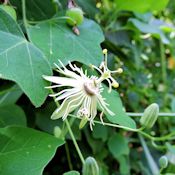 Yellow passion flower (Passiflora lutes L). Yellow passion flower (Passiflora lutes L). |
 Yellow passion flower (Passiflora lutes L) berries in the fall. Yellow passion flower (Passiflora lutes L) berries in the fall. |
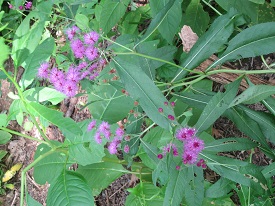 New York ironweed (Vernonia noveboracensis) New York ironweed (Vernonia noveboracensis) |
 Hairy leaf cup/bears foot (Smallanthus uvedalia) Hairy leaf cup/bears foot (Smallanthus uvedalia) |
Native plants can improve ecological functionality of landscapes and provide ecological services like stormwater retention, cleaner air and erosion and sediment control. Native plants can improve soil health. Healthy habitats have plants and animals (producers and consumers) in balance. Increasing diversity of plants can help keep pest populations in check.
 Joe Pye weed (Eutrochium purpureum) Joe Pye weed (Eutrochium purpureum) |
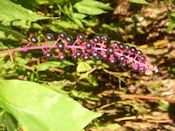 Pokeweed (Phytolacca americana) berries Pokeweed (Phytolacca americana) berries |
 A young common box turtle (Terrapene carolina) was at home on the site. A young common box turtle (Terrapene carolina) was at home on the site. |
By trying to control invasive plants and support more native plants, this project is one small way we can restore lost biodiversity, strengthen the resource base for wildlife and for people and create a more robust environment.
Controlling Invasive Plants
Since 2018, volunteer teams have diligently worked to pull up and root out invasive species, such as stiltgrass (Microstegium vimineum), mile-a-minute (Persicaria perfoliata), porcelainberry (Ampelopsis brevipedunculata), English ivy and others. This is an ongoing effort.
We try to have several sessions a month from May to October. In the winter, we work on controlling English ivy in multiple places. We train volunteers to identify about five targeted invasive plants and in the methods for controlling them. To join us, email This email address is being protected from spambots. You need JavaScript enabled to view it. with “Invasives” in the subject line and check our homepage for forthcoming events.
To learn about common invasive plants in the Washington, see “Plant Invaders of Mid-Atlantic Natural Areas” at https://www.invasive.org/alien/pubs/midatlantic/midatlantic.pdf.
For more information on Northern Virginia’s native plants, visit Plant NOVA Natives at www.plantnovanative.org and the Virginia Native Plant Society at www.vnps.org.
Partners, Grants
Our partners in this project are the National Park Service, Earth Sangha and the Audubon Society of Northern Virginia. Our efforts are also supported by grants from the Audubon Society of Northern Virginia, the National Environmental Education Foundation and the I-495/95 Express Lanes and by many generous member donors.
Thank you to Bob Veltkamp, Greg Nemetz, Bernie Krell and Colin Surovell for the sign noting the project. Thank you to Laura Sebastianelli for initiating two Chronolog stations, one at this site, both of which we installed. We encourage visitors to take photographs at the station and send them in. To view submitted photos, visit www.chronolog.io. Put “Dyke Marsh” in the box that says Filter by Project and our two cameras will appear.
Thank you to the dedicated employees of the George Washington Memorial Parkway, National Park Service, for partnering with us on this project.
 Trudi Hahn and Nancy Herrman helped remove invasive plants. Trudi Hahn and Nancy Herrman helped remove invasive plants. |
 Mara Surovell tackled mile-a-minute (Persicaria perfoliata). Mara Surovell tackled mile-a-minute (Persicaria perfoliata). |
 Jim Gearing and Ed Eder installed the chronolog station. Jim Gearing and Ed Eder installed the chronolog station. |
 In the spring, plants are about one foot high. In the spring, plants are about one foot high. |
 Colin Surovell and Bernie Krell installed a sign at the native plant site. Colin Surovell and Bernie Krell installed a sign at the native plant site. |
All photos by Glenda Booth.
Taking Action
U.S. Army Corps of Engineers Will Not Proceed with Proposed Floodwall at Belle Haven
In 2022, the U.S. Army Corps of Engineers (USACE) proposed to build a six- to seven-foot-high wall just west of the George Washington Memorial Parkway. In April 2024, the USACE, in a 284-page fina environmental assessment, announced that the Corps will not go forward with the proposed Belle Haven floodwall at this time. You can read the Final Integrated Feasibility Report and Environmental Assessment here. For more details and FODM’s views, click here.
NPS Regulations Prohibit Jet Skis in Dyke Marsh
 |
| Photo by Lake Mead National Recreation Area - Andrew Cattoir |
After receiving reports of jet skis operating in Dyke Marsh, on November 11, 2023, FODM asked GWMP Superintendent Charles Cuvelier to take some steps to make the public and the Belle Haven Marina managers aware of the National Park Service (NPS) regulatory prohibition against jet skis.
Superintendent Cuvelier responded on April 22, 2024, and advised us that he notified the Belle Haven Marina concessioner that NPS regulations at 36 CFR 3.9 prohibit jet skis and other personal watercraft in the Dyke Marsh Wildlife Preserve.
The regulation at 36 CFR 1.4 defines “personal watercraft” in part as “a vessel, usually less than 16 feet in length, which uses an inboard, internal combustion engine powering a water jet pump as its primary source of propulsion. The vessel is intended to be operated by a person or persons sitting, standing or kneeling on the vessel, rather than within the confines of the hull.” You can read the regulations, 36 CFR 3.9, at https://www.ecfr.gov/current/title-36/chapter-I/part-3/section-3.9.
Below we share the superintendent’s April 22 response letter to the FODM, along with the park’s notice to the concessioner and map of Dyke Marsh.
GWMP acted after we contacted them because several people observed personal watercraft operating in Dyke Marsh. We believe that these watercraft negatively impact wildlife and likely disturbed ospreys that nested near the boat ramp in 2023. Jet skis also impair vegetation and other natural resources and disturb park visitors. While we expect that the marina concessioner will comply with the GWMP’s notice and not allow jet skis to be launched at the boat ramp, neither the concessioner nor the FODM enforces NPS regulations. The U.S. Park Police have the authority to enforce this regulation.
If anyone observes jet skis being launched or operating in Dyke Marsh, we request that you take a photograph and immediately contact the U.S. Park Police at 703‑285‑1000. Ideally you should send the photograph to the Park Police, to Lt. Timothy Wallace (This email address is being protected from spambots. You need JavaScript enabled to view it.). We also ask that you contact the FODM at This email address is being protected from spambots. You need JavaScript enabled to view it. so that we can monitor enforcement.
The Superintendent's response letter to FODM and be viewed here.
On October 23, 2023, the Friends of Dyke Marsh commented on the July 2023 Assessment of Effects Report, George Washington Memorial Parkway “South Section and Mount Vernon Trail Improvements Plan/Environmental Assessment.”
You can view FODM's comments here.
Expressing Concerns about Widening the Mount Vernon Trail
 |
|
 |
| Many trees are growing very close to the trail. Photos by Glenda Booth. |
|
The pumpkin ash trees that FODM Is trying to save, here marked with yellow plastic tags, are very close to the trail and bridge 23. |
| |
|
|
 |
| A barn swallow (Hirundo rustica) pair built a nest under bridge 23 and raised at least four young in July and August 2023. Photo by Todd Kiraly |
On August 21, 2023, FODM submitted the following comments to the National Park Service on their July 2023 Asessment of Effects report.
Thank you for the opportunity to provide comments on the July 2023 Assessment of Effects Report, George Washington Memorial Parkway South Section and the Mount Vernon Trail.
We realize that this phase of the plan focuses on impacts on historic and cultural resources. We hope you have reached out to historic preservation officials in Virginia, Fairfax County, Arlington and Alexandria as well as private groups like the Mount Vernon Ladies Association, the American Horticultural Society (River Farm), Mount Vernon Regional Historical Society and the Friends of Fairfax Archaeology and Cultural Resources.
We are pleased that the parkway will not be wider than its current footprint and urge you to maintain its historic character.
We agree with your goal to “not diminish the significance or integrity of the historic property” (page 29). We hope you will consult with FODM on your plans, especially if designs will have adverse environmental impacts.
We filed extensive comments on January 16, 2023, and direct you to those in making your final plans. Our views have not changed. (These comments appear below the next section on this web page.)
We oppose increasing impervious surfaces, harming and destroying mature native trees and native plants; staging construction in the preserve without restoring habitat; and other adverse impacts to an already fragile and diminishing wetland complex.
Our recommendations:
(1) We recommend that you acknowledge (e.g., page 2, page 8, page 19) that the trail is used by many people to observe and study nature; conduct plant, bird and other surveys; host walks; conduct outdoor programs; conduct academic research and other non-recreational purposes. Those uses should be given equal weight in your plans. In describing trail users on page 19, these uses are ignored or omitted.
To base widening the trail on recommendations by American Association of State Highway and Transportation Officials (AASHTO) appears to focus solely on transportation, not the multi-, non-transportation uses we describe above, which are equally and perhaps more important in light of the rarity of the wetlands in the NPS system and challenges in Dyke Marsh, including the decline in biodiversity, native plants, birds, insects and other natural resource degradation.
Naturalists, students, academics, historians and others use the trail, especially bridge 23, for their studies and surveys. It is a prime area for viewing marsh habitat, tidal activity and wildlife.
(2) We question the need to widen the multi-use trail to 10 feet from the current 8 to 9 feet south of Alexandria (page 27) and continue to request a bicycling safety study as we previously recommended. We assume that “safety improvements,” one of the bases of this plan, are supported by documented unsafe conditions. We again ask that you analyze and make publicly available the current state of safe use of the trail by all users, especially bicyclists.
More impervious surface (which your plan acknowledges) can harm and kill trees and other vegetation, introduce more disturbances and invasive plants, increase stormwater runoff, increase human-wildlife conflict, wildlife deaths and further degrade Dyke Marsh.
(3) As expressed on pages 7 and 16, NPS plans to rehabilitate the bridge over Hunting Creek. We believe NPS should consider designs that allow for marsh migration landward, in light of the rising river levels.
(4) We would appreciate more detail on the page 15 statement that NPS will "conduct tree pruning and clear vegetation" at places along the trail. At a minimum, NPS should conduct a thorough tree survey as mentioned on page 27, document what trees are present and avoid further harm to trees and prepare a biological inventory of plants and animals present. The plan should include planting more trees, beyond those impacted by these plans. The parkway is losing many valuable trees. Dyke Marsh alone is losing over 1,000 pumpkin ash trees.
(5) The changes to the Belle Haven marina road appear largely to address crosswalks and the left turn from the parkway into the driveway (pages 9-10). Improving crosswalks and turns off the parkway could make Dyke Marsh visitors’ access more accessible and safer.
(6) On page 15, NPS plans to build a new "comfort station" at Gravelly Point and make amenity improvements along the trail (benches, drinking water, racks for bikes). We continue to urge upgrading the restrooms at Belle Haven Park and make them available in all seasons.
(7) We urge that any drainage and stormwater management changes (pages 28-29) not send more polluted stormwater into Dyke Marsh or the Potomac River. We urge NPS to retain more stormwater onsite and to convince Fairfax County and other jurisdictions to implement measures that retain more stormwater onsite, to prevent it from flowing into the marsh and river. NPS should mitigate any adverse impacts of expanding impervious surfaces.
Since the trail is located in a wetland and floodplain at many points, ponding (page 29) and flooding are inevitable. NPS and trail users should live with it.
Commenting on the U.S. Army Corps of Engineers’ Proposed Belle View Floodwall and Levee, Draft Integrated Feasibility Report and Environmental Assessment (May 2022)
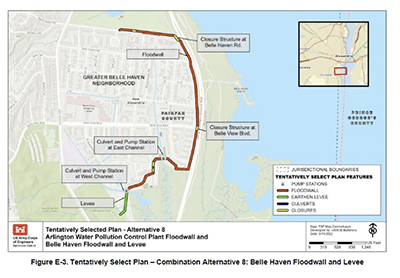
Provided here are the Corps of Engineers Feasibility Report and Environmental Assessment and documents related to comments provided to the U.S. Army Corps of Engineers.
1. U.S. Army Corps of Engineers’ Feasibility Report and Environmental Assessment (Plan)
2. Comments FODM submitted to the Corps
3. FODM summary of all public comments
4. All comments submitted to the Corps
Expressing Concerns about Trail Construction
 |
|
 |
| Many trees are growing very close to the trail. All photos by Glenda Booth |
On December 6, 2022, the George Washington Memorial Parkway (GWM) unit of the National Park Service (NPS) published a proposed plan and environmental assessment to perform some construction on the south GWM Parkway segment and the Mount Vernon Trail. Around 2.5 miles of the trail is in the Dyke Marsh Wildlife Preserve.
On January 16, 2023, FODM submitted the following comments on the NPS’s plans. FODM's January 16 Comments
On January 18, 2023, FODM submitted the following additional comments on the NPS’s plans. FODM's January 18 Comments
The NPS proposal is posted here: https://parkplanning.nps.gov/document.cfm?documentID=124907
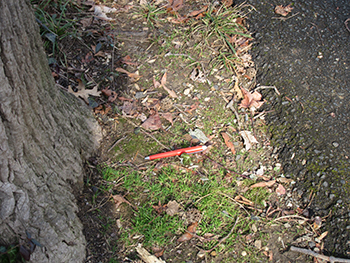 |
|
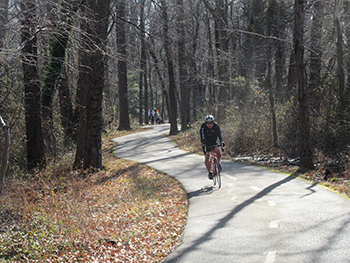 |
| The red pen is 5 1/2 inches long, illustrating how close the tree trunk is to the trail. |
|
The multi-use trail attracts many bikers.
|
 |
|
 |
| The pumpkin ash trees that FODM Is trying to save, here marked with yellow plastic tags, are very close to the trail and bridge 23. |
|
Bridge 23 on the trail and in Dyke Marsh is a favorite spot for nature study.
|
Increasing Local Parks’ Resources
On April 13, 2022, FODM Board member Carolyn Gamble testified before the Fairfax County Board of Supervisors urging these elected officials to increase funding for local parks in the fiscal year 2023 budget. She explained that county officials’ decisions and what happens in local parks affect the larger environment, including the Dyke Marsh Wildlife Preserve.
To view her statement, click here.
Discouraging Single-use Plastics
 On September 14, 2021, FODM submitted comments to the Fairfax County Board of Supervisors supporting a proposed fee on single-use plastic bags. The Board approved the proposal which will go into effect on January 1, 2022. Below are our comments submitted to the Board.
On September 14, 2021, FODM submitted comments to the Fairfax County Board of Supervisors supporting a proposed fee on single-use plastic bags. The Board approved the proposal which will go into effect on January 1, 2022. Below are our comments submitted to the Board.
The Friends of Dyke Marsh urge the Board of Supervisors to approve a fee on certain disposable plastic bags, as proposed in the draft ordinance.
The Friends of Dyke Marsh (FODM) is a non-profit 501(c)(3) organization dedicated to preserving, protecting and restoring the Dyke Marsh Wildlife Preserve. Dyke Marsh is a 485-acre freshwater tidal wetland complex in Fairfax County on the Virginia shoreline of the Potomac River. The Potomac River is a major tributary of the Chesapeake Bay. Dyke Marsh is ecologically diverse, offering habitat for 300 known species of plants, 6,000 arthropods, 38 fish, 34 mammals, 16 reptiles, 14 amphibians, over 275 species of birds and at least 20,000 species of insects.
In our numerous trash cleanup events over many years, we have frequently found plastic debris, including plastic bags and plastic bag fragments within the preserve, at Belle Haven Park and along the Potomac shoreline. The standard grocery and convenience store plastic bags are flimsy and intended for single use. We believe that most are not recycled. Even when properly disposed of, for example, placed in a trash receptacle or recycled, this plastic waste can still make its way into woodlands, vegetated areas and local waterways. We have experienced wildlife getting into trash cans searching for food and spreading trash, including plastic bags, all around.
Microplastics Cause Harm
 Plastics break down into smaller pieces called micro-plastics that infiltrate into the ecosystem and waterways. Micro-plastics continue to break down into such small pieces that they become impossible to completely remove, even during targeted cleanup events.
Plastics break down into smaller pieces called micro-plastics that infiltrate into the ecosystem and waterways. Micro-plastics continue to break down into such small pieces that they become impossible to completely remove, even during targeted cleanup events.
Wildlife, especially birds, turtles and fish, are particularly vulnerable to this plastic pollution. Micro-plastics are frequently ingested by wildlife: birds and fish often mistake them for food or may consume insects and worms that have ingested the plastics. Micro-plastics act as magnets for harmful pollutants and often become laden with chemicals, which are then passed along the food chain from insects and worms to birds and fish and, eventually, to humans.
In addition to the harmful chemicals, we know that when birds ingest these plastics, they can die by starvation because the plastic takes up space in their stomachs and makes the birds feel full of a material that does not break down or provide any nutritional value.
FODM has conducted Dyke Marsh breeding bird surveys for over 27 years, which highlight the presence of plastics and how birds interact with them. During the survey conducted between May and July in 2021, we identified nearly a dozen osprey nests and three bald eagle nests within the preserve. These nests had debris, including plastic bags and bag fragments, in them. Ospreys and their young can get entangled in these plastics, which can result in fatal outcomes.
Reduce Use
 The only way to reduce the amount and harmful side effects of plastic debris in our ecosystem and local waterways is to reduce the amount of plastics produced and used. Creating ways to dispose of these plastics is only a band aid to a growing issue. Therefore, it is critical for our local, state and federal governments and elected officials to implement policy changes such as the proposed plastic bag fee.
The only way to reduce the amount and harmful side effects of plastic debris in our ecosystem and local waterways is to reduce the amount of plastics produced and used. Creating ways to dispose of these plastics is only a band aid to a growing issue. Therefore, it is critical for our local, state and federal governments and elected officials to implement policy changes such as the proposed plastic bag fee.
Fees on single-use plastic bags in other localities and states have proven to raise awareness of their harm and to reduce their use and improper disposal. Bag fees in other areas have proven to reduce plastic bag trash, for example, in Washington, D.C.
These policy changes can help shape behavior and raise public awareness through educational and volunteer opportunities that can be funded through the collected revenue.
More Revenue
According to Census.gov and its July 2019 estimate, there are 1,147,532 residents living in Fairfax County. If half of these residents used one plastic bag during weekly trips to the grocery store, this would total 29,835,884 plastic bags used annually within the county – and this is a conservative estimate.
If this fee is enacted and Fairfax County residents still consume 29,835,884 plastic bags during the 2022 calendar year, at a collection rate of $0.03 per plastic bag, the county could receive $895,076.52 in revenue which the county could use to fund litter reduction and anti-littering education programs to increase public awareness of reducing environmental waste and mitigating litter pollution.
As Virginia Governor Ralph Northam has said, “It takes a village to be stewards of our environment and natural resources.” Enacting the proposed disposable plastic bag fee is a critical, necessary and a long overdue step for Fairfax County, our residents and importantly, our natural resources. We believe that Fairfax County’s residents want to be good stewards of the environment and to protect our precious natural resources on which we all depend.
Thank you for the opportunity to present our views and recommendations.
Sources:
- American Bird Conservancy, “Let’s Talk Trash: Plastic Pollution Birds, and Our Oceans” Webinar, conducted 1July 14, 2021 (https://www.youtube.com/watch?v=XsBXQGOsLPk)
- Fairfax County Government, Office of Environmental and Energy Coordination (https://www.fairfaxcounty.gov/environment-energy-coordination/disposable-plastic-bag-tax-faqs)
- Friends of Dyke Marsh (https://fodm.org/),Dyke Marsh Breeding Bird Survey, conducted May to July, 2021 (source: email from compiler, Larry Cartwright)
- National Park Service, Chesapeake Bay (https://www.nps.gov/chba/learn/nature/facts-and-formation.htm)
- Oceana (https://oceana.org/our-campaigns/plastics?utm_medium=email&utm_source=emailblast&omhide=true&utm_campaign=plastics_wbnr_rec&contactdata=0qShMRlWvyRmQJh6udNOR3OuJkGxkFg1NYnxmJe17YkH3JMMuCyonkEcr4Fxe59dzcbMm5%2bF8yJ7e4UcyX8nqw%3d%3d&emci=ac0a0fa8-04e4-eb11-a7ad-501ac57b8fa7&emdi=4e3ee37f-3ee6-eb11-a7ad-501ac57b8fa7&ceid=309865)
- U.S. Census Bureau (https://www.census.gov/quickfacts/fairfaxcountyvirginia)
- Virginia Conservation Network (https://vcnva.org/governor-signs-plastic-reduction-bill/)
- Virginia’s Legislative Information System (https://law.lis.virginia.gov/vacode/58.1-1745/)
- Alice Ferguson Foundation, https://ggwash.org/view/38159/the-data-proves-the-dc-bag-fee-is-working
Stemming the Trash Flood
Trash cans, trash traps, dumpsters and storm drain gutter guards may keep some trash out of Dyke Marsh and our waterways, but the real solution to the never-ending stream of trash is to stop generating it in the first place. On October 19, 2020, Zach Huntington, Clean Streams Program Manager for Clean Fairfax (www.cleanfairfax.org), conducted a briefing on the trash menace and possible solutions.
Solid waste collections are increasing in Northern Virginia. In fact, Fairfax County is the second largest trash collector among local jurisdictions in the United States. Republic, a company that services Fairfax County is the second largest hauler in the U.S. and their national average has increased by 30 percent this year. The county has seen a 40 percent increase in residential trash tonnage since last year and a 30 percent increase in curbside collection since the March 2020 onset of the coronavirus pandemic.
He described several litter prevention legislative solutions, including plastic bag fees, polystyrene bans, increasing litter taxes and extended producer responsibility. You can view the presentation here.
Some bills anticipated in the 2021 Virginia General Assembly are described on the Litter Free Virginia website, https://litterfreeva.org/legislation-tracker/. In addition to FODM, other organizations represented were the Porto Vecchio Waterfront Committee, the Audubon Society of Northern Virginia, Friends of Little Hunting Creek and the Friends of Accotink Creek.
FODM Weighed in on GWM Parkway Safety Study
The National Park Service (NPS) is conducting a safety study of the south segment of the George Washington Memorial Parkway. After a July 11, 2019 public meeting, NPS had a public comment period which ended on August 21. FODM submitted the following comments. Read here.
FODM on the Future of Claude Moore Farm Park, May 23, 2019
In 2019, the George Washington Memorial Parkway unit of the National Park Service is considering a concept plan for the Claude Moore Farm area of Turkey Run Park. FODM submitted the following comments on May 23, 2019 and stressed the importance of conducting a comprehensive biological inventory of the natural resources there and preserving conservation corridors.
FODM on the Future of Claude Moore Farm Park, October 26, 2019
On October 26, 2019 FODM submitted the following comments on the National Park Service's proposed three concepts for the former Claude Moore Farm area of Turkey Run Park.
Oxon Hill Farm
On June 25, 2019, FODM wrote to the National Park Service’s (NPS) Acting Director, Mr. Dan Smith, and urged NPS not to develop Oxon Hill Cove National Park and Oxon Hill Farm, to preserve its biodiversity and not to trade it for land elsewhere. Read FODM's letter here.














































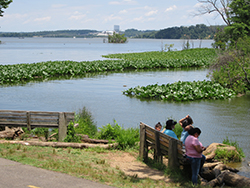











 On September 14, 2021, FODM submitted comments to the Fairfax County Board of Supervisors supporting a proposed fee on single-use plastic bags. The Board approved the proposal which will go into effect on January 1, 2022. Below are our comments submitted to the Board.
On September 14, 2021, FODM submitted comments to the Fairfax County Board of Supervisors supporting a proposed fee on single-use plastic bags. The Board approved the proposal which will go into effect on January 1, 2022. Below are our comments submitted to the Board. Plastics break down into smaller pieces called micro-plastics that infiltrate into the ecosystem and waterways. Micro-plastics continue to break down into such small pieces that they become impossible to completely remove, even during targeted cleanup events.
Plastics break down into smaller pieces called micro-plastics that infiltrate into the ecosystem and waterways. Micro-plastics continue to break down into such small pieces that they become impossible to completely remove, even during targeted cleanup events.  The only way to reduce the amount and harmful side effects of plastic debris in our ecosystem and local waterways is to reduce the amount of plastics produced and used. Creating ways to dispose of these plastics is only a band aid to a growing issue. Therefore, it is critical for our local, state and federal governments and elected officials to implement policy changes such as the proposed plastic bag fee.
The only way to reduce the amount and harmful side effects of plastic debris in our ecosystem and local waterways is to reduce the amount of plastics produced and used. Creating ways to dispose of these plastics is only a band aid to a growing issue. Therefore, it is critical for our local, state and federal governments and elected officials to implement policy changes such as the proposed plastic bag fee. 



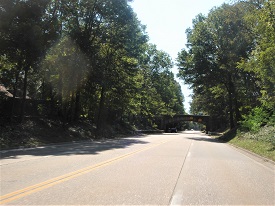

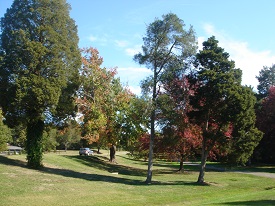



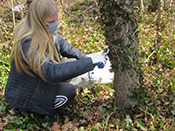




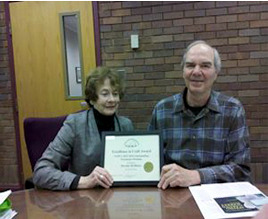

 Friends of Dyke Marsh, Inc. is a non-profit 501(c)(3) organization.
Friends of Dyke Marsh, Inc. is a non-profit 501(c)(3) organization.